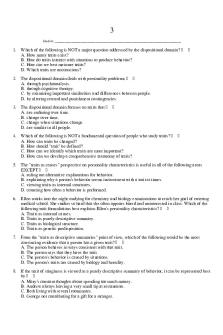Strategies for Studying Perception (Cont) PDF

| Title | Strategies for Studying Perception (Cont) |
|---|---|
| Author | Isabel Meza |
| Course | Perception & Action |
| Institution | University of Rochester |
| Pages | 11 |
| File Size | 726 KB |
| File Type | |
| Total Downloads | 34 |
| Total Views | 170 |
Summary
BCS 151
Dr. Tadin
Notes go over how we study perception for research....
Description
BCS 151 Prof. Tadin 6 September 2018
Strategies for Studying Perception (Cont.)
What are the Limits of Perception? (Psychophysics: thresholds, JND, PSEs) Psychophysical Methods: -Signal Detection Theory1 →if someone’s threshold is lower, does that mean they’re more sensitive? (dependent on each person’s criterion) →problem of criterion: ~we must never take a person’s testimony, however sincere, that he has felt nothing, as proof positive that no feeling has been there (there is a stimulus, but it hasn’t reached our own threshold) ~perceptual decisions are influenced my many factors: *signal strength relative to background level of noise *person’s sensitivity to the signal *relative frequency of occurrence of the signal *person’s level of motivation *costs associated with hits and false alarms *personal biases →solution: ~more sensitivity independently of criterion = SDT →explains perceptual performance (& decision making) under conditions of uncertainty →goal = distinguish performance changes/differences attributable to sensitivity to those attributable to criterion
1 https://isle.hanover.edu/Ch02Methods/Ch02SDT_ROC.html; https://www.youtube.com/watch?v=WnfQ2CPHtwk
(errors can be more costly than others; miss vs false alarm)
→four possible outcomes: 1) hit2 2) miss3 3) correct rejection4 4) false alarm5 →each observation is either a case of “just noise6” or a “signal plus noise”
Signal weaker on the left and stronger on the right Dotted curve is noise, Line is signal; the more separated it is, the easier your task is
2 signal was present and person says “yes” (ex: correct diagnosis of disease) 3 signal was present and person says “no” (ex: physician tells patient that no disease exists when one does) 4 signal was not present and person says “no” (ex: unnecessary operation/treatment) 5 signal was not present and person says “yes” (ex: patient properly diagnosed with no disease) 6 “noise” is anything that complicates detection of “signal” by introducing uncertainty about whether or not the signal is present
in the middle, we are uncertain and try to make a decision
everything to the left is “no I don’t hear it”, everything to the right is “yes I hear it” Curve is probability of distribution saying “no” even though there is a signal, therefore, miss
Criterion can shift can change the types of errors you make The shift is your mental bar
liberal not a lot of misses, but a lot of false alarms conservatives miss a lot, but not a lot of false alarms
→the ROC (Receiver Operating Characteristic) curve7 ~traced out by plotting Hits against False Alarms as the criterion moves ~ex: likeliness of false alarms relative to hit rate
7 https://isle.hanover.edu/Ch02Methods/Ch02SDT_ROC.html
0,0 100,100 diagnose everyone (pick up all hits, but also a lot of false alarms) d’0 hits and false alarms the same
D is doing the better job (a lot of hits, no false alarms) E an C doing the same (same curve) B almost equal
Liberal, Neutral, Conservative want to know if false alarms sensitivity is the same
→explains yes-no decisions →detecting signal in noise8 (S + N) →sensitivity (discriminability) vs criterion (bias) →sensitivity (d’) depends on: ~signal strength ~noise strength ~observer sensitivity →criterion depends on: ~personal bias ~cost/benefit factors (risk) ~signal frequency →ROC curve: ~used to visualize SDT concepts & results
When does perception produce mistakes? (Study of Illusions) 8 what makes detection hard (internal + external noise)
How can we make visible “invisible”?
-Degrading visual stimulation →ex: lowering contrast to where you can’t see it
-Crowding →focusing on limitations in concentration visualizing periphery
-Masking →don’t perceive a target but your brain processed it, therefore affecting your performance
-Motion Induced Blindness →we don’t know why it works; subconscious?
-Binocular Rivalry →showing things in different eyes
-Bistable Figures →flipping perspectives back and forth
Where in the Brain does Perception Occur? (fMRI, EEG, TMS) MRI images brain structure: -how brain is made up; structural differences fMRI images brain function (BOLD9 signal): -see brain in action -1increased neural activity -2increased metabolic demand -3increased blood oxygenation -4higher concentration of oxy-hemoglobin level in blood, changes magnetic susceptibility of hemoglobin -increased bold signals (go through 1-4) -fMRI measures blood flow NOT NEURAL ACTIVITY DIRECTLY -BOLD signal is sluggish (peaks about 5 sec after neural activity which is a lot in brain time) -blind to neural changes that do not alter local metabolic demand -fMRI is a correlational method
9 Blood Oxygenated Level Dependent...
Similar Free PDFs

Best lighting for studying
- 6 Pages

Learning Guide for Perception
- 19 Pages

EMT Shock Handout for studying
- 6 Pages

Perception
- 3 Pages

PERCEPTION
- 10 Pages

CONT PERF 2 Appunti
- 25 Pages
Popular Institutions
- Tinajero National High School - Annex
- Politeknik Caltex Riau
- Yokohama City University
- SGT University
- University of Al-Qadisiyah
- Divine Word College of Vigan
- Techniek College Rotterdam
- Universidade de Santiago
- Universiti Teknologi MARA Cawangan Johor Kampus Pasir Gudang
- Poltekkes Kemenkes Yogyakarta
- Baguio City National High School
- Colegio san marcos
- preparatoria uno
- Centro de Bachillerato Tecnológico Industrial y de Servicios No. 107
- Dalian Maritime University
- Quang Trung Secondary School
- Colegio Tecnológico en Informática
- Corporación Regional de Educación Superior
- Grupo CEDVA
- Dar Al Uloom University
- Centro de Estudios Preuniversitarios de la Universidad Nacional de Ingeniería
- 上智大学
- Aakash International School, Nuna Majara
- San Felipe Neri Catholic School
- Kang Chiao International School - New Taipei City
- Misamis Occidental National High School
- Institución Educativa Escuela Normal Juan Ladrilleros
- Kolehiyo ng Pantukan
- Batanes State College
- Instituto Continental
- Sekolah Menengah Kejuruan Kesehatan Kaltara (Tarakan)
- Colegio de La Inmaculada Concepcion - Cebu









